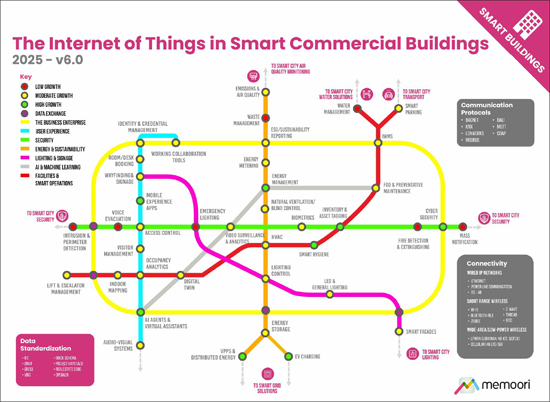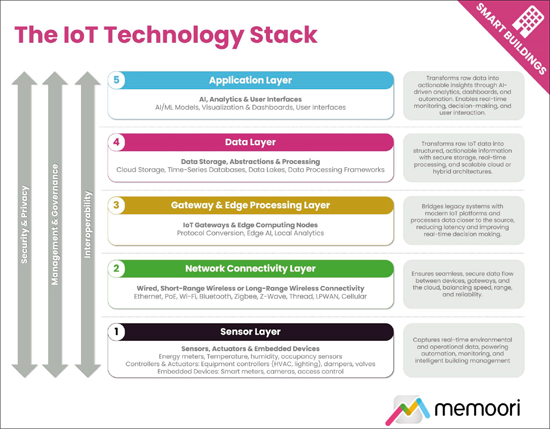 |
市场调查报告书
商品编码
1669753
智慧商业建筑中的物联网设备(2025-2030)- 设备预测、采用、元趋势分析IoT Devices in Smart Commercial Buildings 2025 to 2030 - Device Projections, Adoption & Meta-Trends Analysis |
||||||
商业建筑领域正处于技术转折点,预计到2030年物联网应用将增加一倍以上,达到 41.2亿。
人工智慧和物联网系统的整合创造前所未有的能力,预计智慧建筑人工智慧解决方案市场将以 25.5%的年复合成长率成长,到2028年达到 65亿美元。安全漏洞需要强大的框架。最近发生的引人注目的事件凸显了全面安全策略的重要性,并推动了以下安全策略的采用:
本报告研究了智慧商业建筑中的物联网设备市场,并深入了解了商业房地产领域(包括办公室、零售、饭店和资料中心)的设备渗透率、技术采用模式和实施框架。
范例视图

本报告的详细细分分析和技术路线图为驾驭复杂的智慧建筑格局和识别眼前机会提供了重要指导,同时也为长期转变做好了准备,包括:
范例视图

目录
前言
执行摘要
第1章 物联网生态系
- 物联网的定义
- 物联网技术堆迭
- 建构物联网
第2章 人工智慧在建构物联网中的作用
- 物联网感测器网路中人工智慧的演变
- 人工智慧与物联网的融合
- 人工智慧投资与采用趋势
- AI硬体和处理
- 边缘人工智慧
- 实施挑战与策略建议
第3章 物联网技术前景
- 物联网设备预测
- 依应用划分的物联网设备
- 物联网感测器连接
- 商业建筑业的物联网设备
- 依地区划分的物联网设备
- 感测器技术的准备和成熟度
- 物联网设备创新与新机会
第4章 实施挑战与解决方案
- 系统整合与互通性
- 安全、隐私和资料所有权
- 成本论证与商业案例
- 装置管理与视觉性
- 改造传统建筑系统
第5章 元趋势分析
- 市场投资与招募趋势
- 宏观经济展望
- 地缘政治趋势
- 房地产趋势
- CRE建筑展望
- 环境、社会与治理趋势(ESG)
- 物联网技能与就业市场
第6章 标准与协定
- 开放标准的重要性
- 楼宇自动化协议
- 应用层协定
- 物联网安全标准
- 资料模型与框架
- 标准整合与互通性工作
The Definitive Market Report on IoT Devices & Connectivity Transforming Commercial Real Estate through 2030
The commercial building sector stands at a technological inflection point, with IoT deployments projected to more than double to 4.12 billion by 2030. Our new market assessment provides unprecedented insights into device proliferation, technology adoption patterns, and implementation frameworks across commercial real estate verticals including offices, retail, hospitality, and data centers.
Based on primary research and rigorous data analysis, this report delivers the market intelligence needed to navigate the rapidly evolving smart building landscape. It examines the convergence of IT and OT systems, emerging connectivity protocols, AI integration, and critical security considerations that are fundamentally reshaping how commercial buildings operate and interact with occupants.
The research includes a spreadsheet with all the data tables AND a presentation file with high-resolution versions of the charts.
SAMPLE VIEW

KEY QUESTIONS ADDRESSED ABOUT IOT DEVICES
- How many connected IoT devices have been installed in commercial smart buildings? Memoori estimates that the installed base of IoT devices in commercial buildings is approximately 2 billion and is expected to grow to 4.12 billion by 2030. The report breaks this down by both technology vertical and building type.
- How are connectivity technologies evolving in smart buildings? Wireless technologies (Wi-Fi and Bluetooth/BLE) continue to grow their market share and will represent over 40% of all connections by 2030. The report forecasts sensor adoption by connectivity type across commercial buildings to 2030.
- What are the primary implementation challenges for smart building IoT systems? Organizations face significant integration hurdles from siloed building systems, with 81% reporting IoT-related cyber incidents and over 90% of sensor-generated data remaining unexploited due to technical fragmentation and organizational barriers between IT and operations teams.
The detailed segmentation analysis and technology roadmaps in this report provide essential guidance for navigating the complex smart building landscape, identifying immediate opportunities while preparing for longer-term shifts toward grid-interactive buildings and AI-driven autonomous operations.
Unlike broader IoT market reports, this research specifically addresses the unique requirements of commercial buildings through rigorous bottom-up and top-down modeling approaches. Our dual methodology incorporates detailed building stock analysis, technology adoption metrics, and regional variations validated by industry experts across the supply chain.
WITHIN ITS 243 PAGES AND 15 CHARTS AND TABLES, THE REPORT FILTERS OUT ALL THE KEY FACTS AND DRAWS CONCLUSIONS, SO YOU CAN UNDERSTAND EXACTLY WHAT IS SHAPING THE FUTURE OF COMMERCIAL SMART BUILDINGS.
- AI is transforming building intelligence. The integration of AI with IoT systems is creating unprecedented capabilities, with the market for AI solutions in smart buildings projected to grow at a rate of 25.5% CAGR to reach $6.5 billion by 2028, enabling predictive analytics that has demonstrated significant reductions in HVAC energy consumption.
- Security vulnerabilities demand robust frameworks. Recent high-profile incidents highlight the critical importance of integrated security strategies, driving adoption of NIST, ISO/IEC 27001, and Zero Trust Architecture.
- Standards convergence is accelerating interoperability. The industry is seeing an increase in standards collaboration with Project Haystack, Brick Schema, and ASHRAE developing 223P for unified data semantics, while Matter protocol expansion bridges traditional gaps between residential and commercial systems.
This report provides valuable information to companies so they can improve their strategic planning exercises AND look at the potential for developing their business.
WHO SHOULD BUY THIS REPORT?
The information contained in this report will be of value to all those engaged in managing, operating, and investing in commercial smart buildings (and their advisers) around the world. In particular, those wishing to understand exactly how the Internet of Things is impacting commercial real estate will find it most useful.
SAMPLE VIEW

The model above illustrates the core components of the IoT technology stack, showing the five main layers together with three cross-cutting considerations, Security & Privacy, Management & Governance, and Interoperability.
Table of Contents
Preface
The Executive Summary
1. The IoT Ecosystem
- 1.1. Defining the IoT
- 1.2. The IoT Technology Stack
- 1.3. The Building Internet of Things
2. AI's Role in The Building Internet of Things
- 2.1. The Evolution of AI in IoT Sensor Networks
- 2.2. The Convergence of AI and IoT
- 2.3. AI Investment & Adoption Trends
- 2.4. AI Hardware & Processing
- 2.5. Edge AI
- 2.6. Implementation Challenges & Strategic Recommendations
3. The IoT Technology Landscape
- 3.1. IoT Device Projections
- 3.2. IoT Devices by Application
- 3.3. IoT Sensor Connectivity
- 3.4. IoT Devices by Commercial Building Vertical
- 3.5. IoT Devices by Region
- 3.6. Sensor Technology Readiness & Maturity
- 3.7. IoT Device Innovations & Emerging Opportunities
4. Implementation Challenges & Solutions
- 4.1. System Integration & Interoperability
- 4.2. Security, Privacy & Data Ownership
- 4.3. Cost Justifications & Business Case
- 4.4. Device Management & Visibility
- 4.5. Retrofitting Legacy Building Systems
5. Meta Trend Analysis
- 5.1. Market Investment & Adoption Trends
- 5.2. Macro Economic Outlook
- 5.3. Geopolitical Trends
- 5.4. Real Estate Trends
- 5.5. CRE Construction Outlook
- 5.6. Environmental, Social & Governance Trends (ESG)
- 5.7. IoT Skills & Job Markets
6. Standards & Protocols
- 6.1. The Importance of Open Standards
- 6.2. Building Automation Protocols
- 6.3. Application Layer Protocols
- 6.4. IoT Security Standards
- 6.5. Data Models & Frameworks
- 6.6. Standards Convergence & Interoperability Initiatives
List of Charts and Figures
- Fig 1.1: The IoT Technology Stack
- Fig 1.2: The Internet of Things in Smart Commercial Buildings 2025 v6.0
- Fig 2.1: AI & Machine Learning Techniques and their Smart Building Applications
- Fig 3.1: Global IoT Device Projections. Installed Base of Connected Devices (Bn) 2023 to 2030
- Fig 3.2: Installed Base of IoT Devices in Commercial Smart Buildings 2022 to 2030 (Mn)
- Fig 3.3: Commercial Building IoT Devices by Application 2024 to 2030 (Mn)
- Fig 3.4: Commercial Smart Building IoT Devices by Connectivity Type 2024 to 2030 (Mn)
- Fig 3.5: Commercial Smart Building IoT Devices by Vertical 2024 to 2030 (Mn)
- Fig 3.6: Commercial Smart Building IoT Devices by Region 2024 to 2030 (Mn)
- Fig 3.7: Smart Building IoT Research Trends 2016 to 2023, Number of Publications per Year
- Fig 3.8: Smart Building IoT Patents Trends 2016 to 2024, Number of Patents per Year
- Fig 5.1: IoT Deployment Plans
- Fig 5.2: Quarterly Gross Leasing Volumes for Offices by Region
- A1 Comparative Analysis of IoT Sensing Technologies by Application










